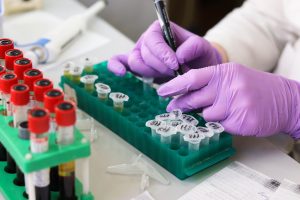Print a Sign-In Sheet | Spanish Version Coming Soon
Formaldehyde is used frequently in medical laboratories, mortuaries, and biology/science classes. It is also found in fingernail polish and hardeners, household products, glues, fabrics, paper product coatings, and plywood. Formaldehyde is used often as an industrial fungicide, germicide, and disinfectant.
It is a colorless, strong-smelling gas found in water-based solutions. Exposure generally occurs through inhalation as a gas or absorption through the skin as a liquid. Please see the information and safety tips below to help keep workers safe.
OSHA Standard 29 CFR 1910.1048
- Applies to all occupational exposures to formaldehyde from formaldehyde gas, its solutions, and materials that release formaldehyde
- Permissible exposure limit (PEL) is 0.75 parts per million (ppm) of air over an 8-hour time-weighted average (TWA)
- Short-term exposure limit (STEL) is 2 ppm during a 15-minute period
- Action level requiring increased industrial hygiene monitoring and initiation of worker medical surveillance is 0.5 ppm over an 8-hour TWA
Formaldehyde Hazards
- Sensitizing agent and can cause an immune system response
- Carcinogenic
- Irritating to eyes, nose, and throat
- Causes coughing and sneezing
- Severe allergic reactions to the skin, eyes, and respiratory tract
- Ingestion may be fatal
- Asthma-like problems from long-term exposure
- Dermatitis and itching from long-term exposure
- Airborne concentrations above 0.1 ppm can cause respiratory tract irritation
- NIOSH considers 20 ppm immediately dangerous to life and health
Protecting Workers
- Identify all workers who may be exposed at or above the action level or STEL
- Conduct initial monitoring and determine their exposure
- Reassign workers who suffer significant adverse effects
- Implement appropriate engineering and work practice controls
- Provide workers with respirators if controls cannot lower exposure to or below the PELs
- Properly label all mixtures or solutions composed of greater than 0.1 percent formaldehyde
- Material capable of releasing formaldehyde at levels above 0.5 ppm during normal use must be labeled as a potential cancer hazard
- Train workers at the time of initial job assignment if they will be exposed to levels of 0.1 ppm or greater
- Train workers whenever a new exposure to formaldehyde is introduced to the work area
- Train workers on an annual basis
- Provide and require personal protective equipment (PPE)
- Impervious clothing
- Gloves
- Aprons
- Chemical splash goggles
- Provide showers and eyewash stations
- Provide medical surveillance for workers
- If exposed to concentrations at or above the action level or exceeding the STEL
- Who develop signs and symptoms of overexposure
- Exposed to formaldehyde in emergencies
- Retain exposure records for 30 years
- Retain medical records for 30 years after employment ends
- Allow access to medical and exposure records to current and former workers or their designated representatives upon request
https://www.osha.gov/OshDoc/data_General_Facts/formaldehyde-factsheet.pdf
KEMI does not assume liability for the content of information contained herein. Safety and health remain your responsibility. This information is to be used for informational purposes only and not intended to be exhaustive or a substitute for proper training, supervision or manufacturers’ instructions/recommendations. KEMI, by publication of this information, does not assume liability for damage or injury arising from reliance upon it. Compliance with this information is not a guarantee or warranty that you will be in conformity with any laws or regulations nor does it ensure the absolute safety of any person, place or object, including, but not limited to, you, your occupation, employees, customers or place of business.

